Anise: Difference between revisions
imported>Todd Coles No edit summary |
imported>Todd Coles |
||
| Line 16: | Line 16: | ||
====Medicinal==== | ====Medicinal==== | ||
Chemicals within the anise fruit can provide several theraputic benefits. [[Anethole]], the chemical compound that causes the licorice flavor of the fruit, can be used to settle an upset stomach and indigestion. Aniseed also contains the chemicals [[creosol]] and [[alpha-pinene]], which function as expectorants, and [[dianethole]] and [[photoanethole]], which behave similarly to [[estrogen]]. | Chemicals within the anise fruit can provide several theraputic benefits. [[Anethole]], the chemical compound that causes the licorice flavor of the fruit, can be used to settle an upset stomach and indigestion. Aniseed also contains the chemicals [[creosol]] and [[alpha-pinene]], which function as expectorants, and [[dianethole]] and [[photoanethole]], which behave similarly to [[estrogen]].<ref>{{cite web | ||
|url=http://www.healthline.com/galecontent/anise/2 | |||
|title=Anise Information on Healthline.com | |||
|accessdate=2009-02-28 | |||
}}</ref> | |||
==References== | |||
<references/> | |||
Revision as of 10:30, 28 February 2009
Anise (Pimpinella anisum), also known as aniseed, is an annual herbaceous plant in the Apiaceae family that produces oil-rich fruits that have a distinct licorice taste. Native to the Mediterranean and first cultivated in Egypt, Anise is now produced in Mexico, the Middle East, Eastern Europe, Chile, Pakistan, and China. The aniseed can be used in cooking, potpourri, and herbal medicine.
Anise should not be confused with the similar tasting star anise.
Description
Anise grows to between 18 and 24 inches in height with bright green feather-like leaves and blooms with small white clusters of flowers. The seeds are grey-brown and oval in shape, measuring 2-4 milimeters. One plant will yield approximately two tablespoons of fruit.
Cultivation
Anise is grown from seed and should be planted where it will reside throughout it's life, as it does not respond well to being transplanted. It is planted in the spring and takes about three months to flower. Anise is best suited for dry, well drained soil in an area where it will receive full sun.
Usage
Culinary
The fruit, frequently erroneously referred to as a seed, is most commonly used in flavored liqueurs such as ouzo and absinthe. It is also used to flavor breads, cakes, cookies, and candies.
Medicinal
Chemicals within the anise fruit can provide several theraputic benefits. Anethole, the chemical compound that causes the licorice flavor of the fruit, can be used to settle an upset stomach and indigestion. Aniseed also contains the chemicals creosol and alpha-pinene, which function as expectorants, and dianethole and photoanethole, which behave similarly to estrogen.[1]
References
- ↑ Anise Information on Healthline.com. Retrieved on 2009-02-28.
